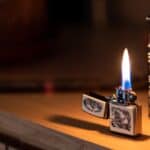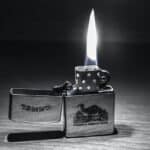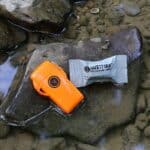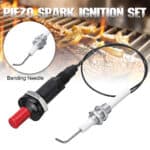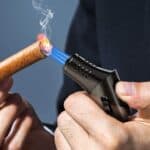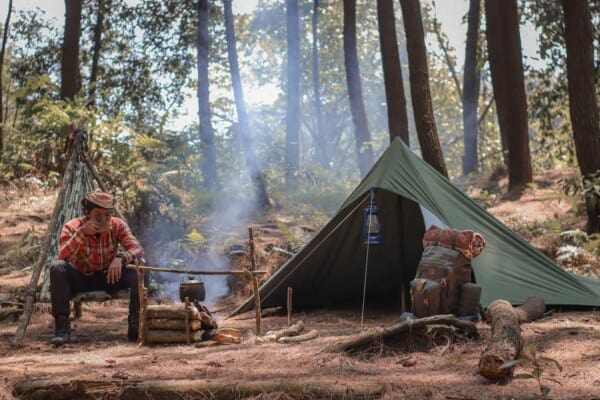Fire. We’ve all been fascinated by it since we were kids; the discovery of fire was an incredible evolutionary step in human history. As such, none can deny playing with matches as a kid or thinking that one of the coolest things ever was a Zippo lighter.
But what we didn’t know at that time was that there are many types of lighters, aside from the disposable Bic lighter we all knew, such as variations with electric ignition or different types of fuels. Who knew, right?
How to classify lighters
Well, this list was put together to make everything regarding lighters crystal clear. The first question that comes to mind is: what makes one lighter different from another? These portable flame creators usually ignite fuel held within its case, once a spark is created. So, to classify lighters we should consider:
- the ignition method
- the type of fuel used
- how long will the fuel last
- strength and direction of the flame
- number of flames – yes, there can be more than one
- interesting features – such as design or the ability to handle the rain
Now, the first and foremost feature of any lighter should be functionality, which is why there are various crossovers on the market today. But, that’s alright; we can only appreciate the cornucopia of choices.
Speaking of functionality, it’s always a good idea to have a lighter around, God only knows what might happen next. A lighter is going to help you light your way, keep warm, even ‘cut’ or melt threads of various materials – this might come in handy in extreme situations, or simply if you’re pulled over by a technical fault of your vehicle.
What type of lighter are you looking for?
Yes, you might not even know that – yet. But, before making a decision, you should be aware of the fact that not all lighters are created equal.
You should consider all the different options and might make the difference between a happy end or not – feel free to ignore all this drama and let’s just hope you won’t have to go through such moments, ever.
What are lighters good for?
Aside from people who smoke, who else uses a lighter and what for? Starting a fire, for one thing, and for that, any lighter will do – granted, a candle lighter might make for a better choice. How about lighting up the dark? Survival mode implies keeping it moving and searching for whatever is necessary during the day; as such, repairing your gear and cooking will be made once the sun goes down.
Staying warm is also important if you’re in the wild or lost in the dark; if starting a fire is not possible, a lighter will at least warm your hands and give you hope.
Your lighter should, in theory, be:
- durable – since we’re already discussing the apocalypse and survival mode. You’re on the run, in a hurry, and packing a lot of gear; you really don’t need to be looking for the lighter and find it cracked or damaged, and that there’s fluid all over.
- refillable – you should be able to use it more than once, that’s for sure. There is a limit to what anyone can carry, and going for extra light fuel is a better idea than packing loads and loads of lighters.
- waterproof – this is of major importance. Regardless of weather conditions, your lighter should be there, waiting to serve your best interests and able to handle the pouring rain. Some lighters work even underwater!
- handsfree – usually, one of your hands is stuck working the lighter, but that is far from being convenient. However, any type of survival situation may require you to use both hands, which is why the option to leave the lighter to the side, while it still handles its business, and being able to do something else might be appreciated. I’m just saying.
- lightweight – we were talking about fuel cans just a few lines before, and the fact that too many lighters will have a major negative impact on your back should always be considered. In fact, survival is all about minimalism and optimization; every single ounce added to your backpack or gear might make the difference between life or death, in the long run – multiple Hollywood creations testify to that. The lighter, the better.
We might as well say a few words about fuel types.
Depending on what refillable lighter you decide upon, you need to know what type of fuel it uses – no need to carry around something you don’t need; then again, fuel is fuel and will always come in handy in survival situations. Let’s move on.
It should be considered that the wrong fuel might break your lighter, which is definitely not a good idea. But before going off the grid, it might be useful to learn just a bit more about each of the fuel types you might encounter when using a lighter.
- Butane is affordable and easy to find, at least today, although it’s highly flammable and easy to lose – one tiny crack in the canister, and it’s gone.
- Naphtha is more common in burners, which means a wick is needed before using it. Extremely volatile, this fuel requires attention when handled.
- Charcoal is the type of fuel you usually use when lighting up your grill and preparing for a feast. Made with a petroleum solvent, this is not that common and not easy to find in difficult situations.
Types of lighters
You probably realize by now that there are a few types of lighters out there. Which one is your favorite, that is something we will find out by the end of this list. Meanwhile, we should say a few words about each one, thus making sure you make an informed decision. Here we go!
Zippo lighter
You’ve seen one, even as a kid – in movies, or people using them at Rock concerts. A Zippo lighter is small and easy to use, you simply set them down and let them burn. A bit on the heavy side, with this lighter the fuel tends to evaporate – this means, having it sit there for no reason will mean that the next time you need it won’t be of use.
Zippo lighters have been mesmerizing us for almost a century now; you just spin a spark wheel against a flint inside, and a spark ignites fluid in a wick. The latter will remain lit until you cut off the Oxygen supply by closing the lid.
They will last forever, although you might need to replace the flint from time to time; and windy conditions will not turn these lighters off. Also worth mentioning is that it not be a good idea to use alternative fuels; some may clog it, others can cause your lighter to explode.
Make sure you are careful when you refuel this lighter; accidents may happen – like adding a bit too much fuel, dripping, and trying out the lighter quickly afterward. You may find yourselves with your hand on fire as I did.
Since the fuel evaporates in 3 to 4 days, Zippos are not a good idea if you plan on going camping. However, if you want to make a cool statement: go for it!
Stormproof torch lighter

Not designed for Stormtroopers, if that’s what you were thinking about, these lighters can handle anything. They were meant to offer security, in the sense that starting a fire will be possible, regardless of what’s going on around you. This means that bad weather conditions won’t ruin the day, and since these lighters are also waterproof, good news seem to keep on coming.
Small in size and light on the pocket, these lighters are just what you needed to be part of your survival kit, but you should also consider that cold temperatures make them difficult to operate and you will require a bit of cash to make use of since fuel is a bit more expensive. It might be worth it, though.
Capsule & peanut lighters

Small and sometimes attached to a keychain, these tiny capsule lighters are easy to use and the fuel they use is inexpensive and available everywhere. This means you won’t know they’re there until you need them, and it will not cost you a lot to refill. Nothing but good news!
On the other hand, you should be careful and check if the lighter is properly closed since it’s very easy for this thing to come apart and ruin your day. Speaking of which, the fuel tends to evaporate over time which is why it might be a good idea to keep extra fuel on hand.
BIC lighter
Remember those cute lighters sitting on gas station counters or in the supermarket? Cheap to buy, easy to replace, these BIC lighters have made someone a fortune. What you should also remember is that they aren’t able to be refilled, and are also relatively fragile – not characteristics worthy of an item useful in a survival situation.
Well, truth be told, you can use the spark wheel to create a flame – and it’s a bit difficult. This lighter uses butane, which easily evaporates if you’re not careful or the casing is damaged. And, to top it all off, these lighters don’t work well in windy or wet conditions. Great for a night indoors, lighting your cigarette; other than that…
Floating lighters

The name says it all. These lighters float on water and bring light in the darkness if the situation calls for it. What’s truly useful is the fact that you can actually increase or decrease the flame, depending on what you need it for you could need light, but you are more likely to need heat or fixing something.
Easy to refill, these lighters are quite useful; however, cold environments make them a bit less reliable and evaporation is also an issue if we’re honest. I’m sure that most people use these for decorative purposes rather than anything else.
Piezo Spark Ignition Lighters
The spark wheel is gone with these lighters; instead, you get a button that, once pressed, hits a quart element. The resulting electric voltage ignites the Butane inside the lighter, and voila.
Featuring an adjustable flame and childproof abilities, this lighter makes for an affordable choice. However, they don’t work well in windy or wet conditions and, as many of you have found out by now, the ignition doesn’t always do its job. Going camping or fighting the zombie apocalypse is not recommended with this lighter by your side.
Butane Torch Lighters

Jet lighters, as they are called, butane torch lighters store fuel in a pressurized chamber. while a nozzle allows it to create an intense flame. One thing that’s worth noting: use matches when lighting up your cigar, thus allowing it to maintain its aroma.
Torch lighters allow you to aim the flame in any direction, which might come in handy in difficult situations. But, the intense flame means that fuel will be depleted quite quickly. And you should also be aware of the fact that torch lighters are not allowed on airplanes – watch out for trouble. However, since these lighters are refillable, windproof, and waterproof, they are still worth the attention.
Electric Coil Lighter

The flameless lighters, as some say about them, these battery-operated fire creators work like this: electricity heats a coil inside the lighter, which lights cigarettes or anything else pressed against the coils. Easy to use, and reusable, these lighters don’t require any fuel – the good news is that there is no risk of losing fuel or any need for fuel.
However, the coils make it difficult to light anything other than a cigarette and you could very well end up with a blown lighter in your backpack if too much heat or a short affects this lighter. It wasn’t designed to go into the wilderness, that’s for sure; make a note of that.
Electric Arc Lighter

Also flameless lighters, these particular ones make use of an arc lighter. High-voltage electricity makes an arc of charged plasma between two electrodes, resulting in a very hot and stable flame – these lighters will handle winds, rain, and don’t even require any fuel.
Before making up your mind, you should consider brand reputation and battery life prior to making a purchase. Also worth remembering is that lithium-ion batteries are not limitless and will not last forever.
Permanent Match

This is pretty interesting. The forever match is a unique crossover between matches and a lighter. It features a metal chamber, where the fuel resides, while a spark stick with a wick inside completes the ensemble. The wick absorbs fuel, and the user removes the spark stick and strikes it against an abrasive surface – you won’t have to look for one, it’s found on the chamber. How cool is that?
If you’re thinking ‘Resident Evil’, this is the lighter for you. They look cool, handle strong wind, and are interesting; on the other hand, you will need to refuel the lighter quite often – about every 100 lights. The good news is that the manufacturers have thought up a gasket, which prevents Naptha fuel from evaporating. Looking good!
Candle Lighters

These utility lighters are quite boring, to be honest – or, maybe it’s just me. I didn’t know why, but I associate them with elderly people and their effort to light up the oven; as such, these lighters seem boring.
The long neck will make it easier to keep your fingers healthy or go for that all-around romantic vibe by lighting candle wicks – I have to say, the models with flexible necks seem ideal, at home or in the wild, although their overall aspect inclines towards a sensitive and easily damageable product.
Don’t forget about the need to refill this lighter, from time to time; as such, I am inclined to leave this one behind when running into the desert.
Pipe Lighters

Pipe lighters stand out due to the fact that the flame comes out of the side of the lighter. This was the solution they found to the fact that pipes have proven to be difficult to light with traditional lighters.
So, here’s what’s what: these lighters don’t work well in windy or wet conditions, which is why making a fire in a hurry or while hiding in the woods waiting for civilization to die out is not a good idea – at least, not with this lighter around.
The question is: which do you think would be the best lighter to do so? I have to admit, I’m still partial to the Zippo. I just can’t help it!









